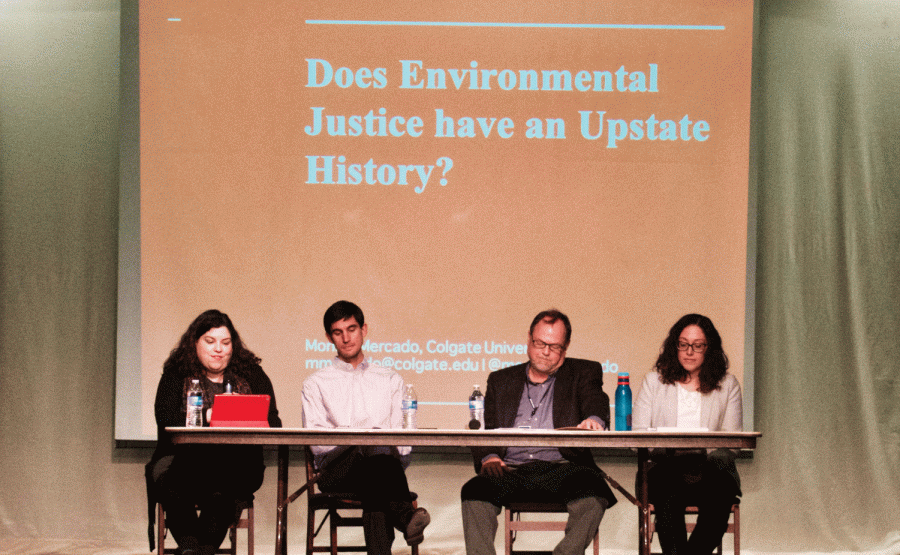Colgate Joins Nationwide Endangered Data Week with Environmental Justice Panel
Colgate professors gathered in the Palace Theater to discuss environmental justice as part of Endangered Justice Week. Each member spoke about the importance of endangered data as well as environmental justice in upstate New York.
The Colgate community came together at the Palace Theater to explore the issue of environmental justice in Upstate New York on Tuesday, February 27. This panel discussion was one of 40 events held nationwide as part of Endangered Data Week, which ran from February 26 to March 2.
Endangered Data Week grew out of a tweet on February 2017 by the Director of the Lab for the Education and Advancement of Digital Research at Michigan State University Brandon Locke.
“We need Banned Data Week. Like Banned Books Wk, draw attn to HUD, EPA data being suppressed & encourage data literacy, engaged scholarship,” Locke wrote in his tweet.
This message gained traction, especially in the librarian community, and a month later librarians gathered with the goal of preserving environmental data.
Endangereddataweek.org describes the initiative as a “new, collaborative effort, coordinated across campuses, nonprofits, libraries, citizen science initiatives and cultural heritage institutions, to shed light on public datasets that are in danger of being deleted, repressed, mishandled or lost.”
This event was co-hosted by Assistant Professor of Environmental Studies at Colgate Andy Pattison and Head of Research and Instruction in the University Libraries Joshua Finnell. The panel included Colgate Assistant Professor of History Monica Mercado, Director of Environmental Justice of the NYS Department of Environmental Conservation Rosa Mendez, Director of Environmental Health of the Madison County Health Department Geoffrey Snyder and Public Health Statistician of the Madison County Health Department Alex Coyle.
Pattison opened the event by describing the importance of the use of science and technical information as well as environmental justice in policy-making. He felt the event combined many important ideas, including community-based research.
Each member of the panel then spoke individually about the importance of both endangered data and environmental justice in their organizations and in Upstate New York.
Professor Mercado began by addressing the question, “Does environmental justice have an Upstate history?” She explained that in her classes, she starts with white European settlement of Native lands, 300 to 400 years ago. Since then, there has been a variety of other environmental justice issues. The most well-known of these is the first Superfund Site, Love Canal.
Rosa Mendez spoke next, giving the NYS Department of Environmental Conservation (DEC)’s definition of environmental justice: “Environmental justice is the fair treatment and meaningful involvement of all people regardless of race, color, culture, national origin, income and educational levels with respect to the development, implementation and enforcement of protective environmental laws, regulations and policies.”
She then described how the DEC promotes transparency and engagement with data through their Open Data website and the new DEC infoLocator that will launch soon.
When asked about climate change data repression at the EPA, Mendez explained that DEC collects its own data on climate change. However, changes in funding from the federal government under the current administration is a concern.
“Where the federal government steps back, New York steps in,” Mendez said, adding that this requires the department to stretch its resources.
Snyder explained what the Madison County Health Department does to promote environmental health for all. Some examples of environmental justice in his work include the difficulty of ensuring rabies vaccination in Amish communities and the lack of funding in Madison County for Lead Hazard Abatement. He also listed many examples of the data his office collects every day to provide services to the public.
Coyle finished the panel discussion with examples of how data can reveal issues of environmental justice.
First, Coyle showed how data could contribute to the ongoing discussion of the development of Interstate 81. Using data sets, he found that the areas with the highest levels of traffic were in closest proximity to socially vulnerable communities as measured by the poverty level and highest educational attainment. There were also patterns in the area around the interstate in health measures, both mental health and leisure-time physical activity. Coyle was clear that the interstate was not the only reason for these issues, but used this example to highlight the importance of involving data like this into planning, in order to include all communities and their relevant issues.
Coyle later spoke about how data and environmental justice are relevant specifically to Madison County – through climate change. There are varied models of climate change and its effects on agriculture, which is highly relevant to this local economy. Though the outcomes are still uncertain, changing climate could lead to lower incomes based on lower corn and milk production due to rising temperatures. Data already shows that farmers have a suicide rate five times higher than the general population and double the rate of war veterans. In this already-stressful job, climate change and economic loss could worsen this problem. Threats to the data we have surrounding climate change through threats to funding, consistent and standardized collection and local data impact our ability to address the issue.
“To me, data are individual points. We can go outside and we can see what the temperature is. That’s a single point in time. But really, data by itself is not that helpful to people. We need to put data together to create information and we need to get that information out to community members, to policy makers, and to media, so that information can be used to develop knowledge and wisdom as we work towards developing these healthy communities,” Coyle said.
First-year Christina Weiler reflected on the event.
“I thought the panel brought much-needed attention to environmental injustices. I’m learning that environmental justice movements don’t always reach college campuses, and students don’t usually take action against inequality and discrimination issues around their own communities. Panels give students an opportunity to become informed and focus on the work to come,” she said.
Senior Ashlea Raemer also felt the panel addressed important issues.
“I never thought about the issue of endangered data until last spring when climate change information started disappearing from the EPA website. I think that public access to information, especially regarding environmental and public health, is particularly important from an environmental justice perspective. Data is often needed to add ‘credibility’ to what people report about their communities from personal observation,” she said.
Contact Sarah Anderson at [email protected].




